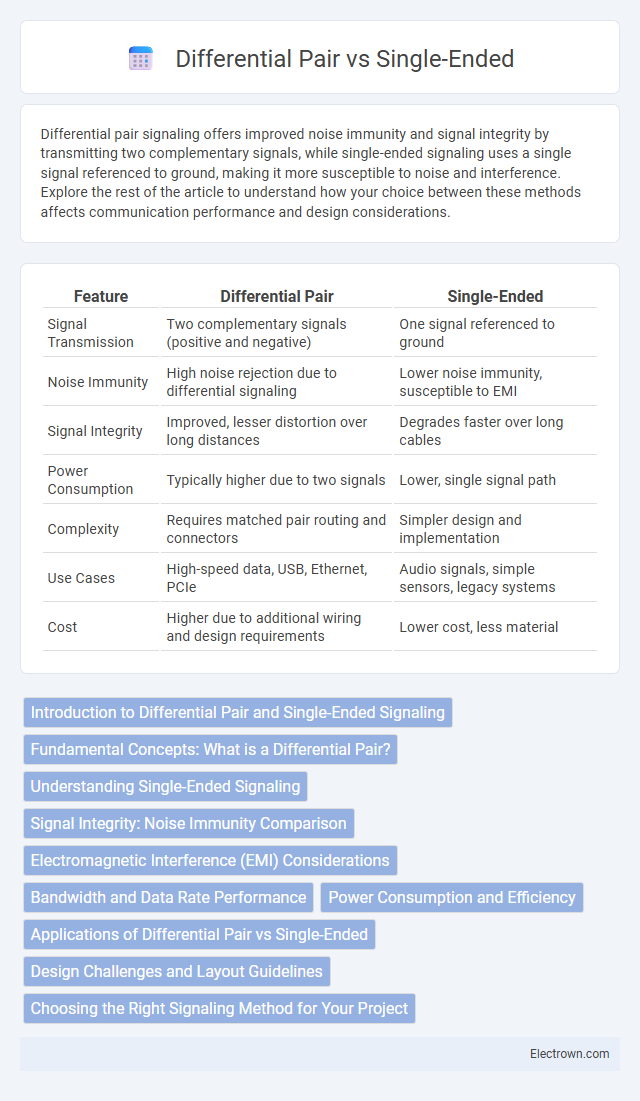Differential pair signaling offers improved noise immunity and signal integrity by transmitting two complementary signals, while single-ended signaling uses a single signal referenced to ground, making it more susceptible to noise and interference. Explore the rest of the article to understand how your choice between these methods affects communication performance and design considerations.
Table of Comparison
| Feature | Differential Pair | Single-Ended |
|---|---|---|
| Signal Transmission | Two complementary signals (positive and negative) | One signal referenced to ground |
| Noise Immunity | High noise rejection due to differential signaling | Lower noise immunity, susceptible to EMI |
| Signal Integrity | Improved, lesser distortion over long distances | Degrades faster over long cables |
| Power Consumption | Typically higher due to two signals | Lower, single signal path |
| Complexity | Requires matched pair routing and connectors | Simpler design and implementation |
| Use Cases | High-speed data, USB, Ethernet, PCIe | Audio signals, simple sensors, legacy systems |
| Cost | Higher due to additional wiring and design requirements | Lower cost, less material |
Introduction to Differential Pair and Single-Ended Signaling
Differential pair signaling uses two complementary signals to transmit data, minimizing noise and improving signal integrity in high-speed communication systems. Single-ended signaling transmits data using one signal line referenced to a common ground, making it simpler but more susceptible to noise and interference. Understanding these differences helps you choose the right signaling method for reliable and efficient data transmission in your electronic designs.
Fundamental Concepts: What is a Differential Pair?
A differential pair consists of two complementary signal lines transmitting equal and opposite signals, enhancing noise immunity and signal integrity. Unlike single-ended signals that reference a common ground, differential pairs rely on the voltage difference between the two lines to convey information. This approach reduces electromagnetic interference and improves performance in high-speed data communication and sensitive analog circuits.
Understanding Single-Ended Signaling
Single-ended signaling uses a single conductor to transmit a voltage signal referenced to a common ground, making it simpler but more susceptible to noise and electromagnetic interference (EMI). The signal integrity in single-ended designs heavily depends on the quality of the ground connection and the physical layout of the PCB traces. This method is widely used in low-speed, short-distance communication but is less effective in high-speed, noisy environments compared to differential pair signaling.
Signal Integrity: Noise Immunity Comparison
Differential pairs provide superior noise immunity compared to single-ended signals by transmitting two complementary signals, allowing common-mode noise to be canceled out at the receiver. Single-ended signals are more susceptible to electromagnetic interference (EMI) and crosstalk because they reference a single ground line, making them vulnerable to voltage fluctuations. The enhanced signal integrity of differential pairs is critical in high-speed data communication and sensitive analog circuits where minimizing signal distortion and error rates is essential.
Electromagnetic Interference (EMI) Considerations
Differential pairs significantly reduce Electromagnetic Interference (EMI) by carrying two opposite signals that cancel out radiated emissions and improve noise immunity. Single-ended signals, referencing a common ground, are more susceptible to EMI, as they radiate more electromagnetic noise due to unbalanced return currents. Properly designed differential pairs minimize EMI and crosstalk, enhancing signal integrity in high-speed digital and RF applications.
Bandwidth and Data Rate Performance
Differential pairs provide superior bandwidth and data rate performance compared to single-ended configurations due to their ability to reject common-mode noise and reduce electromagnetic interference. This noise immunity allows differential signals to maintain signal integrity at higher frequencies, supporting faster data transmission and increased bandwidth. Optimizing your system with differential pairs can significantly enhance performance in high-speed communication applications.
Power Consumption and Efficiency
Differential pair signaling consumes more power than single-ended signaling due to the simultaneous switching of both lines, but it offers higher noise immunity and better signal integrity, which can improve overall system efficiency in noisy environments. Single-ended signaling typically uses less power because it sends data on one line referenced to a common ground, making it more energy-efficient for short-distance or low-speed applications. Your choice between differential pair and single-ended should balance power consumption needs with the required signal reliability and noise tolerance for optimal performance.
Applications of Differential Pair vs Single-Ended
Differential pair signaling is widely used in high-speed data communication applications such as USB, Ethernet, and HDMI, where noise immunity and signal integrity are critical. Single-ended signals are common in lower-speed, simpler devices like audio equipment and basic sensor interfaces due to their lower complexity and cost. Choosing the appropriate signaling method impacts your system's performance in environments with varying levels of electromagnetic interference and data rate requirements.
Design Challenges and Layout Guidelines
Differential pair design requires precise impedance matching and minimal skew between traces to ensure signal integrity and reduce electromagnetic interference, posing challenges in maintaining consistent trace width, spacing, and length. Single-ended layouts demand careful isolation and grounding techniques to minimize crosstalk and noise susceptibility, especially in high-frequency applications. Effective layout guidelines for differential pairs include controlled impedance routing, symmetrical trace geometry, and avoiding stubs, while single-ended traces benefit from short, direct paths with consistent impedance and robust ground referencing.
Choosing the Right Signaling Method for Your Project
Selecting between differential pair and single-ended signaling hinges on factors like noise immunity, signal integrity, and PCB complexity. Differential pairs excel in high-speed data transmission and environments with significant electromagnetic interference, delivering lower signal distortion and enhanced noise rejection. Single-ended signals offer simplicity and reduced cost for low-speed, short-distance applications where noise is less critical.
Differential Pair vs Single-Ended Infographic

 electrown.com
electrown.com